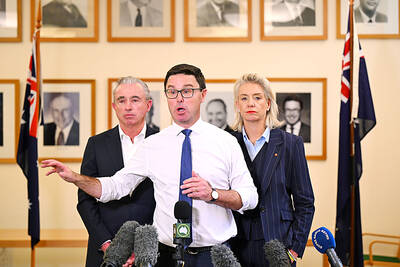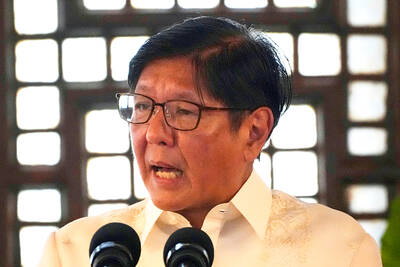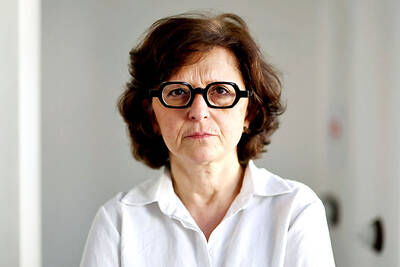Scientists yesterday said intelligible speech is learnt in part through nerve signals from the vocal tract, a discovery that could open up an ambitious avenue of therapy for the deaf.
Muscles and receptors in the mouth and throat retain a memory of their position and feeling when a word is uttered, and their signals provide key input for the brain as it hones the power of speech, they suggest.
Researchers David Ostry and Sazzad Nasir at McGill University in Montreal carried out an unusual experiment into an enduring mystery: Why is it that many deaf people are still able to speak coherently, sometimes years after losing their hearing?
They recruited five middle-aged people who had lost their hearing in adulthood and were now profoundly deaf but had a cochlear implant to pick up sounds.
With the implant turned off, the five were asked to repeat four specific words while the front of their lower jaw was gently pulled forwards by a small device attached to their bottom row of front teeth.
The movement was only tiny but it was sufficient to deform the sounds emitted from the volunteers’ mouth.
The point of the experiment was to see whether the volunteers were able to adapt to the sudden speech deformation, even if they could not hear the sound they were making.
The four words were “saw,” “say,” “sass” and “sane,” chosen because their vowel, dipthong and fricative — the hiss of the “s” — require a very precise jaw position to be pronounced intelligibly.
Even though they were unable to hear the deformed sounds they made, the volunteers progressively learnt to fix the errors in their pronunciation as they ran through a program of 300 utterances.
In fact, they learned as fast as a comparison group of people of a similar age and with normal hearing who performed the same experiment.
“The deformation [by the machine] is in the orders of millimeters. Even when these individuals can’t hear what they’re saying, when the motion path of the jaw is changed just a tiny amount, it’s enough to prompt a corrective response,” Ostry said.
The study is published online by the journal Nature Neuroscience.
He and Nasir attribute the remarkable adaptive power to “mechanoreceptors,” or nerves and soft tissues in the vocal tract, which remember how they should feel when a word is pronounced properly.
Ostry said that the discovery shows that the brain corrects our speech through two simultaneous inputs — through hearing the sound that we make, and also through these subtler feedback signals.
“When a child learns to talk, it gets two kinds of information,” Ostry said.
“One is the auditory information, being the sound of its own voice. At the same time, it also gets information from receptors that are in the skin and in the muscles. These receptors develop not only in expectation of what words should sound like, they also develop an expectation of what the word should feel like,” he said.
Ostry said the experiment focused only on the muscles of the jaw and facial tissues, but the outcome suggests “mechanoreceptors” are also likely to exist in the lips, the tongue and the muscles of the larynx.
“It is conceivably a basis for speech therapy, absolutely,” he said.

BACKLASH: The National Party quit its decades-long partnership with the Liberal Party after their election loss to center-left Labor, which won a historic third term Australia’s National Party has split from its conservative coalition partner of more than 60 years, the Liberal Party, citing policy differences over renewable energy and after a resounding loss at a national election this month. “Its time to have a break,” Nationals leader David Littleproud told reporters yesterday. The split shows the pressure on Australia’s conservative parties after Prime Minister Anthony Albanese’s center-left Labor party won a historic second term in the May 3 election, powered by a voter backlash against US President Donald Trump’s policies. Under the long-standing partnership in state and federal politics, the Liberal and National coalition had shared power

CONTROVERSY: During the performance of Israel’s entrant Yuval Raphael’s song ‘New Day Will Rise,’ loud whistles were heard and two people tried to get on stage Austria’s JJ yesterday won the Eurovision Song Contest, with his operatic song Wasted Love triumphing at the world’s biggest live music television event. After votes from national juries around Europe and viewers from across the continent and beyond, JJ gave Austria its first victory since bearded drag performer Conchita Wurst’s 2014 triumph. After the nail-biting drama as the votes were revealed running into yesterday morning, Austria finished with 436 points, ahead of Israel — whose participation drew protests — on 357 and Estonia on 356. “Thank you to you, Europe, for making my dreams come true,” 24-year-old countertenor JJ, whose

NO EXCUSES: Marcos said his administration was acting on voters’ demands, but an academic said the move was emotionally motivated after a poor midterm showing Philippine President Ferdinand Marcos Jr yesterday sought the resignation of all his Cabinet secretaries, in a move seen as an attempt to reset the political agenda and assert his authority over the second half of his single six-year term. The order came after the president’s allies failed to win a majority of Senate seats contested in the 12 polls on Monday last week, leaving Marcos facing a divided political and legislative landscape that could thwart his attempts to have an ally succeed him in 2028. “He’s talking to the people, trying to salvage whatever political capital he has left. I think it’s

A documentary whose main subject, 25-year-old photojournalist Fatima Hassouna, was killed in an Israeli airstrike in Gaza weeks before it premiered at Cannes stunned viewers into silence at the festival on Thursday. As the cinema lights came back on, filmmaker Sepideh Farsi held up an image of the young Palestinian woman killed with younger siblings on April 16, and encouraged the audience to stand up and clap to pay tribute. “To kill a child, to kill a photographer is unacceptable,” Farsi said. “There are still children to save. It must be done fast,” the exiled Iranian filmmaker added. With Israel